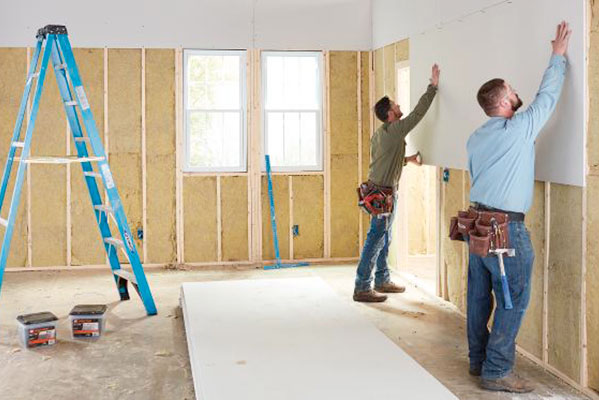Relied On Drywall Fort Worth Specialists for Seamless Results
Full Overview to Reliable and Trustworthy Drywall Setup
Drywall installment is a vital part of any building or renovation job, requiring a precise strategy to guarantee both effectiveness and reliability. Comprehending the essential tools and techniques is critical, along with identifying usual mistakes that can cause below average results. By methodically preparing the space and carrying out best techniques, one can attain a remarkable finish that stands the test of time. It is essential to explore the nuances of each step in the process, as they jointly add to the overall success of the drywall installation. What details approaches can elevate your strategy?
Vital Tools for Drywalling
When beginning on a drywall installment project, having the right tools is critical for achieving a specialist finish. Important devices include a drywall knife, tape step, and a T-square, which are essential for exact measurements and smooth cuts. A drywall lift is also highly useful, especially for ceiling installments, permitting much easier handling of heavy panels.
For fastening the drywall, a cordless drill and drywall screws are needed. The drill must be geared up with a drywall little bit to guarantee efficiency and accuracy. In addition, an essential device is the drywall saw, which facilitates reducing around electrical outlets and other barriers.

Furthermore, protective equipment such as security glasses and a dust mask are crucial to make certain personal safety throughout the setup process. Utilizing the right tools not just improves the top quality of the installation yet likewise streamlines the process, making the task extra reliable overall.
Preparing the Room

Following, evaluate the condition of the wall surfaces and ceilings. Fix any type of existing damages, such as holes, cracks, or peeling off paint, to make certain a smooth and also surface for drywall application. Additionally, look for electrical outlets, plumbing lines, and a/c ducts, marking their areas to stay clear of complications throughout installation.
It is likewise critical to measure the room accurately, establishing the measurements of the ceilings and walls to compute the appropriate amount of drywall needed. Create an in-depth plan that consists of the design and positioning of the drywall panels.
Installation Methods
Efficient setup strategies are critical for achieving a specialist finish in drywall jobs. Correct measurement and cutting of drywall sheets are fundamental steps. Constantly measure the wall room precisely, permitting any kind of buttons or outlets. Utilize an energy blade for tidy cuts, racking up the paper face and snapping the board along the racked up line.
When hanging drywall, begin from the leading and job downward, guaranteeing that the lengthy edge of the board is vertical to the framework. Secure the sheets with screws rather than nails, which offer higher holding power and lower the danger of popping. Place screws every 12 inches along the sides and every 16 inches in the area of the board.
For corners, utilize corner beads to achieve sharp, clean sides. When mounting on ceilings, utilize a drywall lift or have a companion our website aid in holding the sheets in position (drywall repair). Preserve a space of about 1/4 inch over the flooring and ceiling to accommodate expansion and tightening
Finishing Touches

When the tape is in location, it's time to use the very first layer of joint substance, likewise recognized as mud. Use a 10 blog to 12-inch taping knife to spread the compound uniformly over the taped joints, feathering the sides to blend with the surrounding drywall.
Allow the substance to dry completely, commonly 24 hr. After drying, sand the surface area gently with fine-grit sandpaper to remove any type of blemishes. drywall installation. Repeat the mudding and sanding from this source process, typically a couple of layers, making sure each layer is smooth and flush with the drywall surface area
Common Errors to Prevent
Many Do it yourself enthusiasts run into pitfalls during drywall installation that can endanger the final results. One common mistake is stopping working to appropriately determine and reduce drywall sheets.
An additional constant error is improper attachment. Making use of as well few screws or nails can result in loose drywall, while overdriving bolts can trigger the paper to tear, damaging the framework. It's crucial to preserve regular spacing, commonly every 16 inches, and to make certain that bolts are flush with the surface area.
Moreover, not addressing dampness issues before setup can lead to mold growth and architectural damage. Always examine the setting and use moisture-resistant drywall in high-humidity areas.
Conclusion
Dependable and reliable drywall setup needs careful focus to information throughout the procedure. By making use of vital tools, preparing the room sufficiently, and adhering to finest practices in installation methods, a flawless surface can be attained. Furthermore, mindful application of joint substance and tape throughout the ending up phase boosts toughness and appearance. Staying clear of typical blunders additionally adds to a professional result, highlighting the importance of accuracy and technique in effective drywall tasks.
It is necessary to explore the subtleties of each action in the procedure, as they collectively add to the general success of the drywall installment.When getting started on a drywall setup job, having the right tools is essential for accomplishing a specialist surface.For attaching the drywall, a cordless drill and drywall screws are needed.Properly preparing the room is important for an effective drywall installation.Efficient installment methods are important for achieving an expert finish in drywall projects.